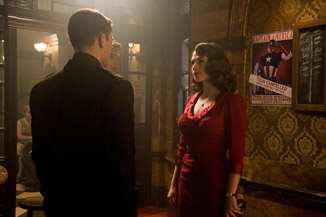|
|
(Comic) Book vs. MovieCaptain AmericaBy Russ BickerstaffJuly 28, 2011
Back in the early-to-mid 20th century, people were more willing to take their heroes on faith. Now we’re less trusting. We’ve been burned before with the whole hero thing and we want to see a resume. Whereas once we were willing to take on faith that our hero was a fine, upstanding man representing all of the more noble ideals of a nation, now he needs a thorough background check. Various authors had tried their hands at fleshing-out the background of the character over the years. Roger Stern did a good job in the pages of the comic book for the character’s 40th anniversary in 1981. Fabian Nicieza did an equally admirable job for a mini-series celebrating the character’s 50th ten years later. With a history now going back 70 years, Captain America’s screenwriters could’ve drawn inspiration from a lot of different sources. The film’s interpretation of the character paints him as a kid from Brooklyn who wants to serve his country. He has tried to enlist quite a few times under various aliases - rejected every time due to physical frailty. He refuses to give up. And Evans does a good job of keeping this kind of altruism grounded in the kind of earthbound emotion that we can accept. So the new incarnation of the hero passes the initial job interview from a cynical audience. Fine, but that’s only the first part of the journey.
[ View other columns by Russ Bickerstaff ]
[ View other Book vs. Movie columns ]
[ Email this column ]
|

|
|
|

|
Friday, November 1, 2024
© 2024 Box Office Prophets, a division of One Of Us, Inc.


